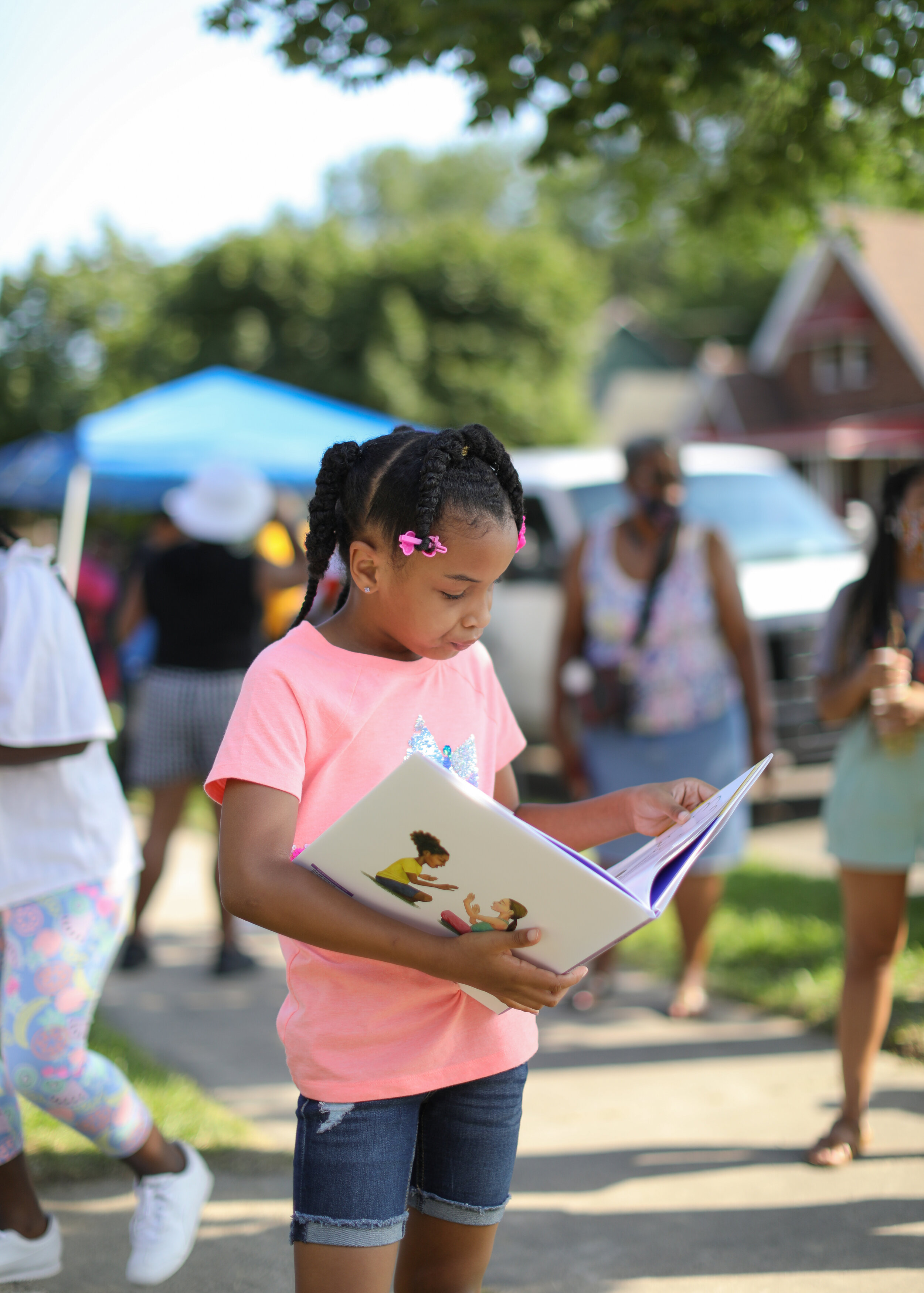Read in Color, a New Little Free Library Project, Reaches the Streets of Detroit
Increasing access to books may be the difference between a child who is literate and one who is not.
By Lauren Brensel
Karen Roberts is not one for basic road trip games. Instead of punch buggy, she and her husband prefer to spot Little Free Libraries as they travel the country in their 2008 Mini Cooper convertible.
A Read in Color Little Free Library in Detroit. Photo by B’Angelo Garrett
Roberts, 64, is an avid fan of Little Free Library, a nonprofit that helps develop book-sharing boxes in communities where residents request them. An added bonus, some of Roberts’ library destinations now feature diverse books highlighting characters of different races, ethnicities and cultural identities.
In May 2020, following the death of George Floyd, Little Free Library launched its Read in Color initiative. For the typical Little Free Library, its sponsor, or “steward,” funds the exterior design and the book content inside. Read in Color libraries, however, are paid for by the Little Free Library organization itself.
Little Free Library, along with its partners, also adds reads that amplify marginalized voices. The goal is simple: increase youth access to diverse literature. The need is highlighted by the Cooperative Children’s Book Center, a research library with data that show only around 30% of 2020 children’s books featured stories about people of color.
Guests at the July 21, 2021 Detroit Read in Color launch clap for speaker Orlando Bailey. Photo by B’Angelo Garrett
After its initial launch in Minnesota, Read in Color is now in the process of expanding to nine cities throughout the U.S. Most recently, the organization opened a Read in Color library in Detroit on July 21, 2021.
“We had 100 people come out. It was a beautiful mesh of people coming together to celebrate community, books and what matters,” Brilliant Detroit co-founder and CEO Cindy Eggleton says.
A young girl reading one of the books from the Read in Color library in Chandler Park.. Photo by Zak Bratto
The opening was held at the Chandler Park location of Brilliant Detroit, an organization with a goal to provide families with young children the resources they need to be successful. Moving forward, Read in Color libraries will be distributed throughout Detroit, totaling 2,500 diverse books for the city’s children to embrace.
Like the other areas welcoming this initiative, Detroit faces a youth literacy issue. In 2017, for instance, Detroit fourth and eighth-graders had the lowest reading scores out of 26 other U.S. urban school districts, according to a report by the National Assessment of Educational Progress.
“A lot of kids — especially as they’re entering into the higher grades — they are still reading at a preschool-kindergarten level,” explains Marva Walker, a Detroit mother of four.
But not everyone is confident that the Little Free Library’s approach is the best solution to improve literacy.
“The idea of it is phenomenal, but then is it really effective? Are kids really utilizing it? Is it really something that has been an enhancement in that community?” Malika Williams, another Detroit mother, questions.
Williams is the creator of the nonprofit L.I.V.E Outreach, which provides underprivileged communities and foster care children with support ranging from financial literacy lessons to hair care advice.
“Me growing up underserved and poor, I’ve basically worked corporate America. I’ve had my opportunity to live on both sides, to be able to talk both languages,” Williams says. “I get a lot of people that want to come back in the community, and they have a lot of great ideas, but then a lot of times it's not all the way effective.”
Six cities have welcomed the Read in Color program so far, with Washington, D.C. hosting its opening in June 2021. The consensus in D.C. is that opening these libraries is a prime way to surge literacy rates.
Children of Washington, D.C. participate in a ribbon cutting at the first Read in Color library opening on June 23, 2021. Photo by Kevin Mielec
“Based upon all the posting on social media from us as well as some of the other news coverage we’ve gotten, it’s been very positive across the board,” says Julian Gross, the communications manager at D.C.’s Read in Color partner, Everybody Wins.
About 33% of the way toward its goal of donating 21 libraries, Everybody Wins plans on completing the project by late September. In the meantime, it must find stewards to maintain the libraries and to continuously ensure that the books are diverse. Without this effort, patrons like Williams worry that Read in Color might sound good on paper but have minimal results in actuality.
“We’re providing (stewards) with more than enough resources, so they know what types of books reflect the areas in which they’re serving,” Gross explains.
Whether it’s Detroit, Washington, D.C. or another city the Read in Color initiative takes to, one commonality remains: access is everything.
“You try to do what you can, but a lot of times, it’s real discouraging because you don't have those resources for your kids,” Williams says. “It's unfortunate because, in Detroit, you have so many schools that lack so many necessities, just the normal things that kids typically need.”
A child explores a Detroit Read in Color library while another dives into one of the diverse books found in the box. Photo by Zak Bratto
Though some may question Read in Color’s ability to strengthen literacy rates, the power of representation in literature is indisputable.
“There are Black and brown children that are not seeing themselves when they read. When you don’t see things, you really can’t imagine things for yourself,” Gross explains.
“We’re all human, we deal with the same things; this is something that humanizes us,” Lauren Gray, Brilliant Detroit’s community engagement manager says. “Every community deserves to have that.”






